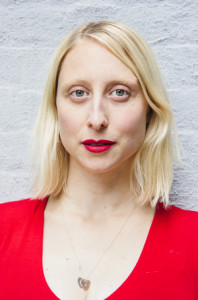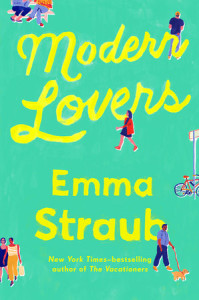 Emma Straub’s latest novel, Modern Lovers, came out on Tuesday—just in time to top your summer reading lists. The book follows a group of college friends and ex-bandmates as they struggle to come to terms with their middle aged, adult lives in Brooklyn, navigating the difficulties of marriage, parenting, and illegal kombucha production. This book has everything we have come to expect from Straub: a richly imagined story of complex human relationships, layered with her characteristic wit, charm, and heart. We reached out to Straub to catch up with her about Modern Lovers and her writing process.
Emma Straub’s latest novel, Modern Lovers, came out on Tuesday—just in time to top your summer reading lists. The book follows a group of college friends and ex-bandmates as they struggle to come to terms with their middle aged, adult lives in Brooklyn, navigating the difficulties of marriage, parenting, and illegal kombucha production. This book has everything we have come to expect from Straub: a richly imagined story of complex human relationships, layered with her characteristic wit, charm, and heart. We reached out to Straub to catch up with her about Modern Lovers and her writing process.
—
Anabel Graff: I know your previous book, The Vacationers, features a family that you had previously written about (The Posts). Where did the inspiration for Modern Lovers come from? Have these characters existed before?
Emma Straub: These people were fresh out the dome—brand new. I’d been trying to write a short story about the teenage son of a couple in a middle-aged garage band, but I could never get more than a paragraph. It was only when I had the wild notion that they deserved a whole novel that I had to back up and widen the scope, that it really came together.
AG: When I read this book, it struck me that, like writers like Jane Austen and Edith Wharton, much of your work uses humor to critique a specific social milieu. One line that made me laugh out loud was: “Most of the customers were women in their thirties wearing clogs for no good reason . . .” (Maybe because I’m nearing 30 and hankering for a pair of cute clogs). Are you conscious of this aspect of your work while you’re writing?
ES: Well, I am 35 and an unrepentant clog-wearer, so partly I’m just mocking myself, but I did very consciously want this book to be funny. For me, writing is a form of entertainment—the act of writing a book is like reading a book, very, very slowly, and I always want to write books for myself to read.
AG: In your books, place is not just a setting but also central to the plot and emotional arc of the story (like Mallorca in The Vacationers or Hollywood in Laura Lamont’s Life in Pictures). It’s almost like your settings act as a metaphorical state for character conflict. Modern Lovers is set a little closer to home in Ditmas Park, Brooklyn. The neighborhood is outgrowing itself, just as the characters are outgrowing their old selves. Why do you think setting is so central to your work?
 ES: This speaks to a larger issue for me, though, which was my reluctance—resistance, really—to writing a Brooklyn book, partly because it is my own social milieu and one that I often find embarrassing in fiction. The way I talked myself into it was setting the book in Ditmas Park, which is architecturally different than brownstone Brooklyn and offered a certain everywhere-ness to the book, I hope. I don’t think of this as a Brooklyn book. It’s not about gentrification, it’s not about hipsters, it’s not either pro or con the idea of “Brooklyn.” It’s really just about these characters, who happen to be New Yorkers, and Brooklynites. That said, it seemed foolish for me not to tell certain jokes (like the clog line) that I knew to be true because of my proximity to this scene.
ES: This speaks to a larger issue for me, though, which was my reluctance—resistance, really—to writing a Brooklyn book, partly because it is my own social milieu and one that I often find embarrassing in fiction. The way I talked myself into it was setting the book in Ditmas Park, which is architecturally different than brownstone Brooklyn and offered a certain everywhere-ness to the book, I hope. I don’t think of this as a Brooklyn book. It’s not about gentrification, it’s not about hipsters, it’s not either pro or con the idea of “Brooklyn.” It’s really just about these characters, who happen to be New Yorkers, and Brooklynites. That said, it seemed foolish for me not to tell certain jokes (like the clog line) that I knew to be true because of my proximity to this scene.
AG: Something I thought was masterful about the book was that all of the plot drama comes from internal pressure rather than external pressure—meaning, the conflict comes from the relationships between the characters rather than being imposed by external events. How did you go about constructing this book?
ES: Well, I guess I’m just the kind of writer who finds big external plots sort of false—at least in my own work. For me, in both actual life and fictional life, it’s all about emotional shifts and small internal changes. That’s what’s interesting to me.
AG: Like The Vacationers, Modern Lovers is told through multiple viewpoints. How did you decide what events to show through which character’s point of view?
ES: This book was far less plotted out/outlined than my previous books, and so I really was discovering what was happening as I wrote. So if I started to write a Harry scene, I didn’t really know what was going to be included. I guess the answer to your question is trial and error and/or intuition and/or it had been a while since I’d written a scene with that character in it. I did want the book to feel pretty evenly weighted between the three couples—the adults and the kids. That was something I figured out as I was writing, too—I thought this was a book about Elizabeth and Andrew, but I was having so much more fun with the lesbians next door.
AG: The book as a whole is infused with other types of art—cooking, film, music, writing (Harry’s forthcoming novel for his Brown thesis project). Were you inspired by certain authors, artists, chefs, or musicians?
ES: Well, I love teenage movies, forever and always. And I love the way teenagers love music and art and sex and everything—I guess this book is my attempt at capturing that feeling you have as a teenager/young adult when you just want to gobble up the whole world. And I got to show both the adults and kids in that state, which was fun. It can be hard to think about parents that way, as having been crazy-eyed youths. Though come to think of it, in many ways my dad is still a crazy-eyed youth. Yesterday, I was at my parents’ apartment, and he was all excited to show me Leanne Shapton’s book, because he’s just discovered her, and I was like, yes, Dad, she rules. He was very surprised that I knew about something cool before he did.
AG: I really was struck by how you handled both Harry and Ruby’s story lines—they were as vital and moving and conflicted as the older characters’ arcs in the book. This was also true of the teenage character in The Vacationers, Sylvia. Have you thought about writing solely from a teenage point of view? Is there a YA novel for Emma Straub on the horizon?
ES: As a matter of fact, yes. I’m working on a YA book now.
AG: Last and very serious question: in an alternate universe, are Sylvia (your character from The Vacationers) and Harry friends at Brown?
ES: Ha! That’s so funny! I didn’t get into Brown. Maybe that’s why I keep sending characters there. I think Harry and Sylvia would make a scorching couple, actually. I hope they ask me to officiate their wedding.
Emma Straub is from New York City. She is the author of the novels The Vacationers and Laura Lamont’s Life in Pictures, and the short story collection Other People We Married. Her fiction and nonfiction have been published in Vogue, New York Magazine, Tin House, The New York Times, Good Housekeeping, and the The Paris Review Daily. She is a contributing writer to Rookie. Straub lives with her husband and kids in Brooklyn.